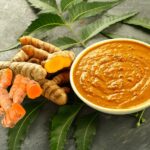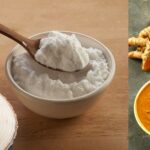Dark spots caused by hyperpigmentation can be stubborn foes that take some time to fade away completely. But incorporating the wonder spice turmeric into your skincare routine offers hope. Loaded with curcumin antioxidants, turmeric has been shown to effectively lighten patches of darkened skin when used topically over weeks and months. So how long does it take for turmeric to start removing dark spots and restoring an even skin tone? Let’s examine what you can expect from consistent turmeric use.
How Long Does Turmeric Take to Remove Dark Spots?
While results may vary depending on individual factors like skin type and spot severity, most people start to notice a visible difference in dark spot appearance within 4-8 weeks of regular turmeric application. Fading continues gradually over 2-6 months as cellular turnover increases and new skin replaces the pigmented layers. Patience and consistency are key to achieving your brightest complexion yet through turmeric’s natural skin soothing and brightening powers over the long run.
Week 1-2 of Using Turmeric
In the first few weeks, you likely won’t observe dramatic changes, but positive effects are taking place beneath the surface. Curcumin’s potent antioxidants are actively fighting free radical damage linked to dark spots. The skin may look slightly less dull or inflamed as turmeric soothes. Stick with your mask 2-3 times weekly.
Week 3-4 of Using Turmeric
By your second month of incorporating turmeric topically, some fading should be noticeable albeit subtle. Spots may appear less dense and defined around the edges. Complexion appears revitalized overall. Curcumin stimulates collagen to plump fine lines subtly as well. Stick to your regimen for ongoing refinements.
Week 5-8 of Using Turmeric
Towards the 2-month mark, dark spots will have noticeably lightened, especially for mild-moderate cases. Regular cellular regeneration better reveals brighter skin underneath pigmented layers as turmeric assists the process. Discoloration patches are generally less concentrated and splotchy at this point. Stay the course!
Month 2-3 Using Turmeric
Dark spots continue lightening and may have faded 30-50% by 3 months with consistency. Skin tone appears brighter and more even overall. Stubborn or deep-set spots require additional time. Monitor your progress monthly and tweak your homemade masks as needed. Moisturize daily to support cellular renewal.
Month 4-6 Using Turmeric
By the 6 month mark, most dark spots treated regularly with turmeric should be reduced by 50-75% and barely noticeable compared to the original darkness. Exceptionally stubborn or deep spots may still be a shade or two darker than the surrounding skin but continue improving. Stick with it to achieve your brightest results!
Conclusion
While turmeric works gradually over weeks and months versus harsh fast-acting chemicals, its nourishing approach yields safer, longer-lasting results with sustained use. Seek medical advice if unusually severe or widespread hyperpigmentation doesn’t respond. For mild-moderate dark spots, routinely apply a turmeric face mask 2-3 times weekly for maximum lightening effects to emerge over 2-6 months and say goodbye to discoloration.
FAQ:
Can turmeric be used on all skin types?
While turmeric shows great promise as a natural skin brightener for many, it’s important to introduce it gradually and test for any sensitivities based on one’s individual skin type and condition. Here are a few pointers on using turmeric masks safely across different complexions:
- Normal/combination skin tolerates turmeric well when mixed with hydrating ingredients like yogurt or aloe vera gel. Apply a pea-sized amount initially.
- Dry skin benefits from heavier carriers like coconut or olive oil to prevent further dehydration. Honey or avocado complements turmeric’s slight astringency too.
- Sensitive skin may experience some stinging at first. Always do a patch test and dilute the turmeric concentration by mixing more moisturizer into the formula.
- Oily skin can use turmeric’s clarifying effects when paired with besan, yogurt or lemon juice to prevent over-drying.
- Those prone to rosacea should monitor for any flushing reaction and discontinue use if irritation occurs. Try a gentler variant with calming aloe or cucumber.
- Darker skin tones adapt well to turmeric but may require longer to see effects on deep hyperpigmentation. Use SPF and avoid harsh exfoliants during the process.
With proper introduction and formulation adjustments based on skin type nuances, turmeric can be incorporated safely into most complexion care routines to nourish from within and brighten naturally over time. Always err on the side of caution, especially when starting out.
Can you recommend any specific brands or products that contain turmeric for different skin types?
Here are some branded product recommendations that safely harness the skin-brightening power of turmeric for different complexions:
For sensitive skin:
Juice Beauty Soothe & Smooth Turmeric Serum – Contains calming aloe and cucumber along with 1% turmeric extract to fade signs of stress and brighten gently.
For dry skin:
Amara Beauty Illuminating Face Oil – Hydrating blend of coconut, olive and jojoba oils plus 0.5% turmeric soothes while improving luminosity.
For normal/combination skin:
Mamaearth Evenly Radiant Turmeric Face Serum – Infused with 1% turmeric extract, hyaluronic acid and vitamin E to combat dullness and moisturize evenly.
For oily/acne-prone skin:
Innisfree Pore Clearing Clay Mask with Green Tea – Combination mask with kaolin clay and 1% turmeric extract absorbs excess sebum to clarify pores.
For all skin types:
The Body Shop Drops of Youth Youth Liquid Peel – Gentle AHA formula with turmeric extract and licorice root refines texture and fades marks over time.
While homemade remedies offer the purest form of turmeric, these trusted cruelty-free brands deliver effective, formulated products to target skins’ unique needs. Always patch test and scan for potential irritants if sensitive.




